Comparison between the PD Characteristics of g3 and Dry Air for Gas-Insulated Switchgears
Abstract
1. Introduction
2. PD Electrode System
3. Experiment and Method
4. Result and Discussion
4.1. Partial Discharge Inception Voltage (PDIV)
4.2. Pulse in Time and Frequency Domains
4.3. Phase-Resolved Partial Discharge (PRPD)
4.4. Correlation between the Output Voltage and Apparent Charge
5. Conclusions
- PDIVThe PDIVs of g3 and dry air are approximately 74–84% and 58–72%, respectively, those of SF6 and about 90–96% and 80–93% those of SF6 in terms of the same gas pressure in the POC and FMP, respectively. In addition, the PDIVs in g3 at 0.4 MPa and dry air at 0.5 MPa are equivalent to those of SF6 at 0.2 MPa in POC, while the PDIVs in g3 at 0.4 MPa and dry air at 0.5 MPa are equivalent to those of SF6 at 0.3 MPa in FMP.
- Pulse in time and frequency domainsThe rising time, falling time, and pulse width of pulses in g3 and dry air are relatively longer than those in SF6. However, it is seen that there are no significant differences according to the gas type. Although the frequency ranges of pulses in all types of gases are similar, the relative amplitude of FFT in dry air is greater than that in g3, and the least in SF6.
- PRPDIn the POC, the discharge pulse occurs at the phase angles of 70° to 88° and 258° to 276° in SF6, 61° to 107° and 247° to 285° in g3, and 49° to 153° and 234° to 332° in dry air. In the FMP, the discharge pulse occurs at the phase angle of 0° to 360°, regardless of the gas type. The average output voltage and the pulse count in dry air are greater than those in g3, and the least in SF6. Especially in POC, it is observed that the pulse count in dry air is much higher than that of g3 and SF6.
- Correlation between output voltage in mV and apparent charge in pCThe correlation between the output voltage in mV and the apparent charge in pC was analyzed according to types of PD defects in each gas when the applied voltage increased. From the results, the output voltage of the UHF sensor increases linearly in accordance with the discharge magnitude, regardless of the gas type in the POC and FMP.
Author Contributions
Funding
Conflicts of Interest
References
- Widger, P.; Haddad, A. Evaluation of SF6 leakage from gas insulated equipment on electricity networks in 200 Great Britain. Energies 2018, 11, 2037. [Google Scholar] [CrossRef]
- Wang, G.M.; Kil, G.S. Measurement and analysis of partial discharge using an ultra-high frequency sensor 202 for gas insulated structures. Metrol. Meas. Syst. 2017, 24, 515–524. [Google Scholar] [CrossRef]
- Kim, S.W.; Jung, J.R.; Kim, Y.M.; Kil, G.S.; Wang, G. New diagnosis method of unknown phase-shifted PD signals for gas insulated switchgears. IEEE Trans. Dielectr. Electr. Insul. 2018, 25, 102–109. [Google Scholar] [CrossRef]
- Beroual, A.; Haddad, A. Recent advances in the quest for a new insulation gas with a low impact on the environment to replace sulfur hexafluoride (SF6) gas in high-voltage power network applications. Energies 2017, 10, 1216. [Google Scholar] [CrossRef]
- Wang, G.M.; Kim, W.H.; Kil, G.S.; Kim, S.W.; Jung, J.R. Green Gas for Grid as an Eco-Friendly Alternative Insulation Gas to SF6: From the Perspective of Partial Discharge under AC. Appl. Sci. 2019, 9, 651. [Google Scholar] [CrossRef]
- Kim, S.W.; Kim, N.H.; Kim, D.E.; Kim, T.H.; Jeong, D.H.; Chung, Y.H.; Kil, G.S. Experimental Validation for Moving Particle Detection Using Acoustic Emission Method. Energies 2021, 14, 8516. [Google Scholar] [CrossRef]
- Akram, S.; Castellon, J.; Agnel, S. Progress in Gas/Solid Interface Charging Phenomena. Coatings 2020, 10, 1184. [Google Scholar] [CrossRef]
- Intergovernmental Panel on Climate Change. Climate Change 2013; Cambridge University Press: New York, NY, USA, 2013; pp. 159–254. [Google Scholar]
- Kieffel, Y.; Biquez, F.; Ponchon, P. Alternative Gas to SF6 for use in High Voltage Switchgears: g3. In Proceedings of the 23rd International Conference on Electricity Distribution, Lyon, France, 15–18 June 2015; pp. 1–5. [Google Scholar]
- United Nations. Kyoto Protocol to the United Nations Framework Convention on Climate Change; United Nations: New York, NY, USA, 1998. [Google Scholar]
- United Nations. Paris Agreement to the United Nations Framework Convention on Climate Change; United Nations: New York, NY, USA, 2015. [Google Scholar]
- Uchii, T. Fundamental Research on SF6-Free Gas Insulated Switchgear Adopting CO2 Gas and Its Mixtures. In Proceedings of the International Symposium on Eco Topia Science ISETSO7, Nagoya, Japan, 23–25 November 2007. [Google Scholar]
- Stoller, P. CO2 as an Arc Interruption Medium in Gas Circuit Breakers. IEEE Trans Plasma Sci. 2013, 41, 2359. [Google Scholar] [CrossRef]
- Rokunohe, T.; Yagihashi, Y.; Endo, F.; Oomori, T. Fundamental Insulation Characteristics of Air, N2, CO2, N2/O2 and SF6/N2 Mixed Gases. IEEE Trans. Power Energy 2005, 125, 619–625. [Google Scholar] [CrossRef][Green Version]
- Okubo, H.; Beroual, A. Recent trend and future perspectives in electrical insulation techniques in relation to sulfur hexafluoride (SF6) substitutes for high voltage electric power equipment. IEEE Electr. Insul. Mag. 2011, 27, 34–42. [Google Scholar] [CrossRef]
- Western Power Distribution. SF6 Alternatives—A Literature Review on SF6 Gas Alternatives for Use on the Distribution Network; Western Power Distribution: Wales, UK, 2018; pp. 6–39. [Google Scholar]
- Hama, H.; Okabe, S. CIGRE WG C4.302; Insulation Co-ordination Related to Internal Insulation of Gas Insulated Systems with SF6 and N2/SF6 Gas Mixtures under AC Conditions. Institute of High Voltage Engineering and System Performance: Paris, France, 2008.
- Hernández, J.L.; Basurto, E.; De Urquijo, J. Electron transport and swarm parameters in CO2 and its mixtures with SF6. J. Phys. D Appl. Phys. 2002, 35, 2264. [Google Scholar] [CrossRef]
- Lee, A.; Frost, L.S. Interruption Capability of Gases and Gas Mixtures in a Puffer-Type Interrupter. Plasma Sci. IEEE Trans. 1980, 8, 362–367. [Google Scholar] [CrossRef]
- Zhao, H.; Li, X.; Tang, N.; Jiang, X.; Guo, Z.; Lin, H. Dielectric properties of fluoronitriles/CO2 and SF6/N2 mixtures as a possible SF6-substitute gas. IEEE Trans. Dielectr. Electr. Insul. 2018, 25, 1332–1339. [Google Scholar] [CrossRef]
- Chen, L.; Widger, P.; Kamarudin, M.S.; Griffiths, H.; Haddad, A. CF3I gas mixtures: Breakdown characteristics and potential for electrical insulation. IEEE Trans. Power Deliv. 2017, 32, 1089–1097. [Google Scholar] [CrossRef]
- Chachereau, A.; Rabie, M.; Franck, C.M. Electron swarm parameters of the hydrofluoroolefine HFO1234ze. Plasma Sources Sci. Technol. 2016, 25, 045005. [Google Scholar] [CrossRef]
- Nechmi, H.E.; Beroual, A.; Girodet, A.; Vinson, P. Fluoronitriles/CO2 gas mixture as promising substitute to SF6 for insulation in high voltage applications. IEEE Trans. Dielectr. Electr. Insul. 2016, 23, 2587–2593. [Google Scholar] [CrossRef]
- Kieffel, Y.; Irwin, T.; Ponchon, P.; Owens, J. Green gas to replace SF6 in electrical grids. IEEE Power Energy Mag. 2014, 14, 32–39. [Google Scholar] [CrossRef]
- Jiang, T.; Meng, X.; Wei, Q.; Jin, L.; Sun, Y. The Development of SF6 Green Substitute Gas. Sustainability 2021, 13, 9063. [Google Scholar] [CrossRef]
- Li, F.; Yoo, Y.W.; Kim, D.K.; Lee, B.H. Impulse Breakdown Behaviors of Dry Air as an Alternative Insulation Gas for SF6. J. Korean Inst. Illum. Electr. Install. Eng. 2011, 25, 24–32. [Google Scholar] [CrossRef]
- Li, Y.; Zhang, X.; Zhang, J.; Fu, M.; Zhuo, R.; Luo, Y.; Chen, D.; Xiao, S. Experimental study on the partial discharge and AC breakdown properties of C4F7N/CO2 mixture. IET J. Eng. Technol. 2019, 4, 12–17. [Google Scholar] [CrossRef]
- Zhang, B.; Uzelac, N.; Cao, Y. Fluoronitrile/CO2 mixture as an eco-friendly alternative to SF6 for medium voltage switchgears. IEEE Trans. Dielectr. Electr. Insul. 2018, 4, 1340–1350. [Google Scholar] [CrossRef]
- Kim, S.Y.; Hong, W.K.; Kim, M.H.; Jin, S.Y.; Kim, K.H. A Comparative Study on the Partial Discharge Characteristics of Dry-air and SF6, ICEPE-ST. In Proceedings of the 2022 6th International Conference on Electric Power Equipment-Switching Technology (ICEPE-ST), Seoul, Korea, 15–18 March 2022; pp. 267–270. [Google Scholar] [CrossRef]
- CIGRE Working Group D1.33. Guide for Partial Discharge Measurements in Compliance to IEC 60270; Technical Brochure No. 366; CIGRE: Paris, France, 2008. [Google Scholar]
- Ilkhechi, H.D.; Samimi, M.H. Application of the Acoustic Method in Partial Discharge Measurement: A Review. IEEE Trans. Dielectr. Electr. Insul. 2021, 28, 42–51. [Google Scholar] [CrossRef]
- CIGRE Working Group B3.24. Benefits Of PD Diagnosis on GIS Condition Assessment; Technical Brochure No. 674; CIGRE: Paris, France, 2017. [Google Scholar]
- CIGRE Working Group D1.03. Risk Assessment on Defects in GIS Based on PD Diagnostics; Technical Brochure No. 525; CIGRE: Paris, France, 2013. [Google Scholar]
- International Electrotechnical Commission. IEC 60270: High-Voltage Test Techniques-Partial Discharge Measurements; International Electrotechnical Commission: Geneva, Switzerland, 2015. [Google Scholar]
- Nechmi, H.E.; Beroual, A.; Girodet, A.; Vinson, P. Effective ionization coefficients and limiting field strength of fluoronitriles-CO2 mixtures. IEEE Trans. Dielectr. Electr. Insul. 2017, 24, 886–892. [Google Scholar] [CrossRef]
- Wang, P.; Akram, S.; Meng, P.; Li, Z.; Montanari, G.C. Design of an Effective Antenna for Partial Discharge Detection in Insulation Systems of Inverter-fed Motors. IEEE Trans. Industr. Electr. 2022, 69, 13727–13735. [Google Scholar] [CrossRef]

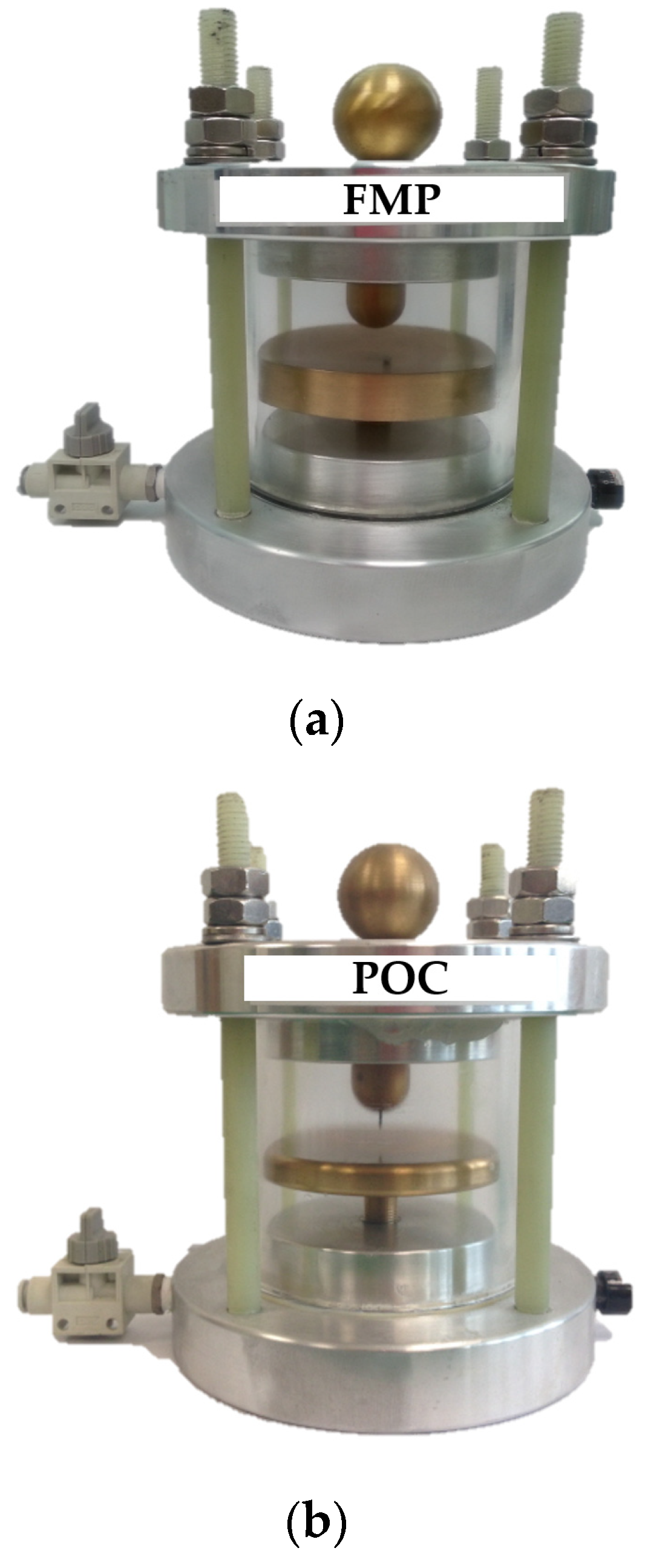

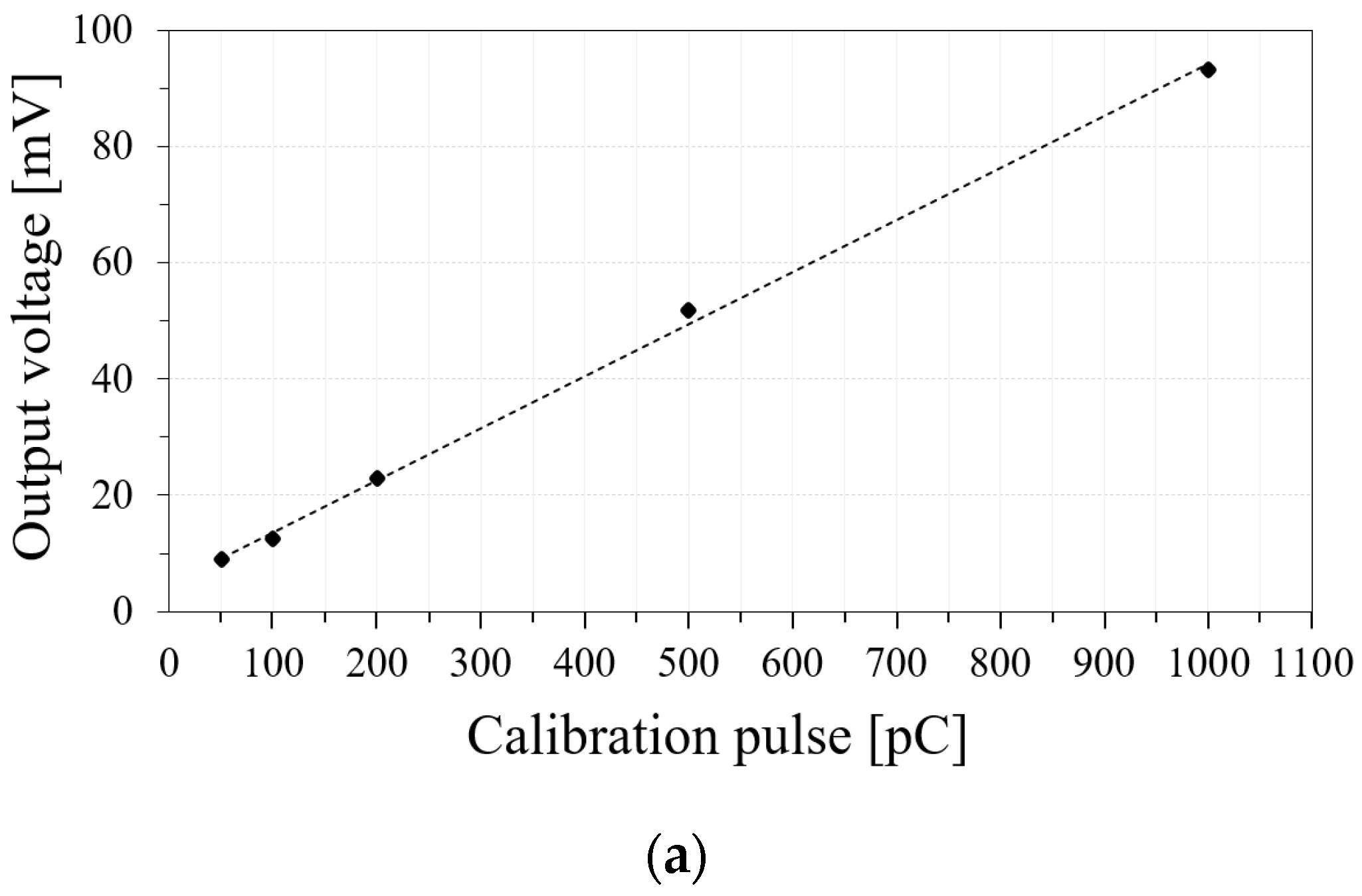
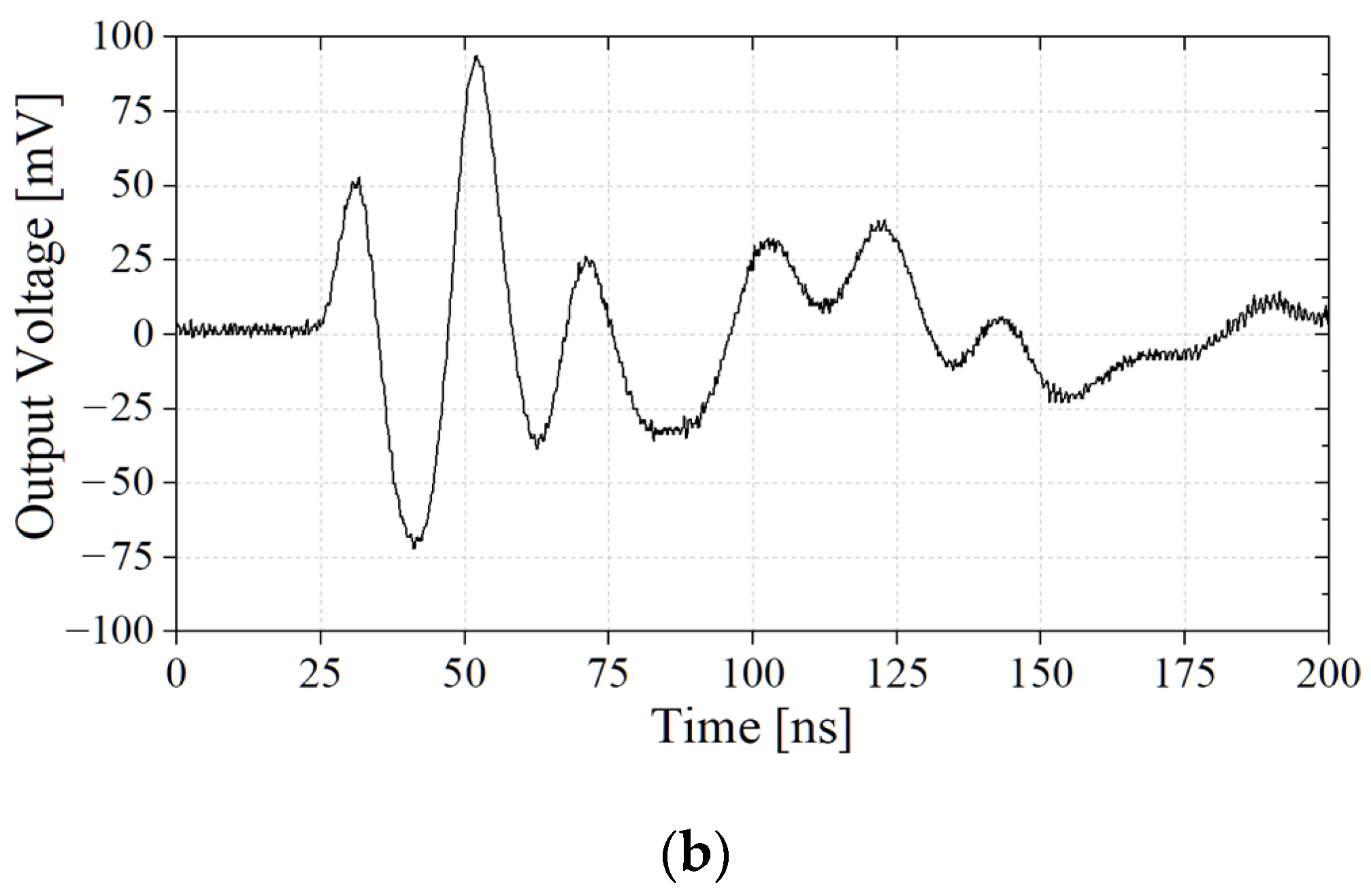
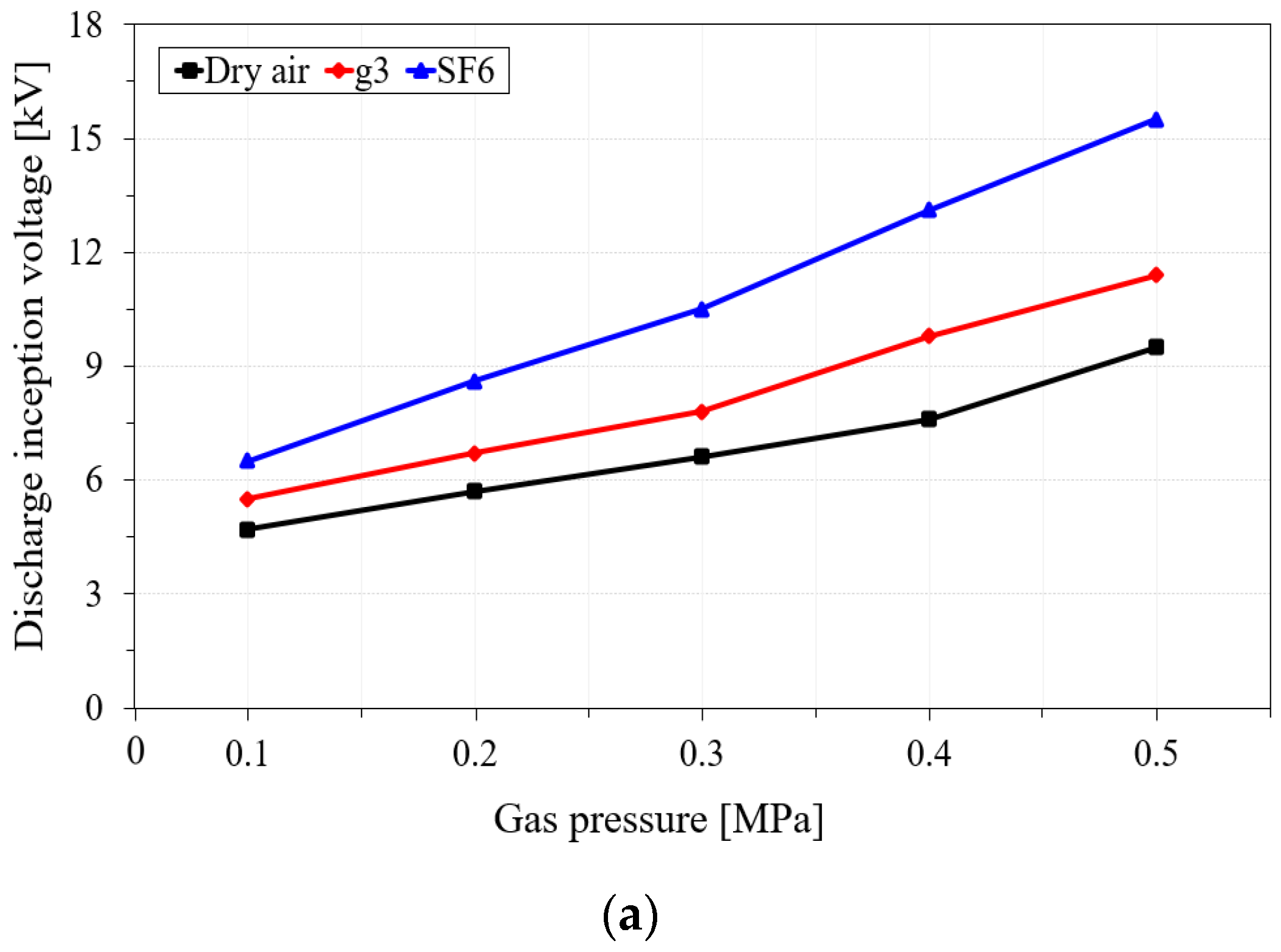




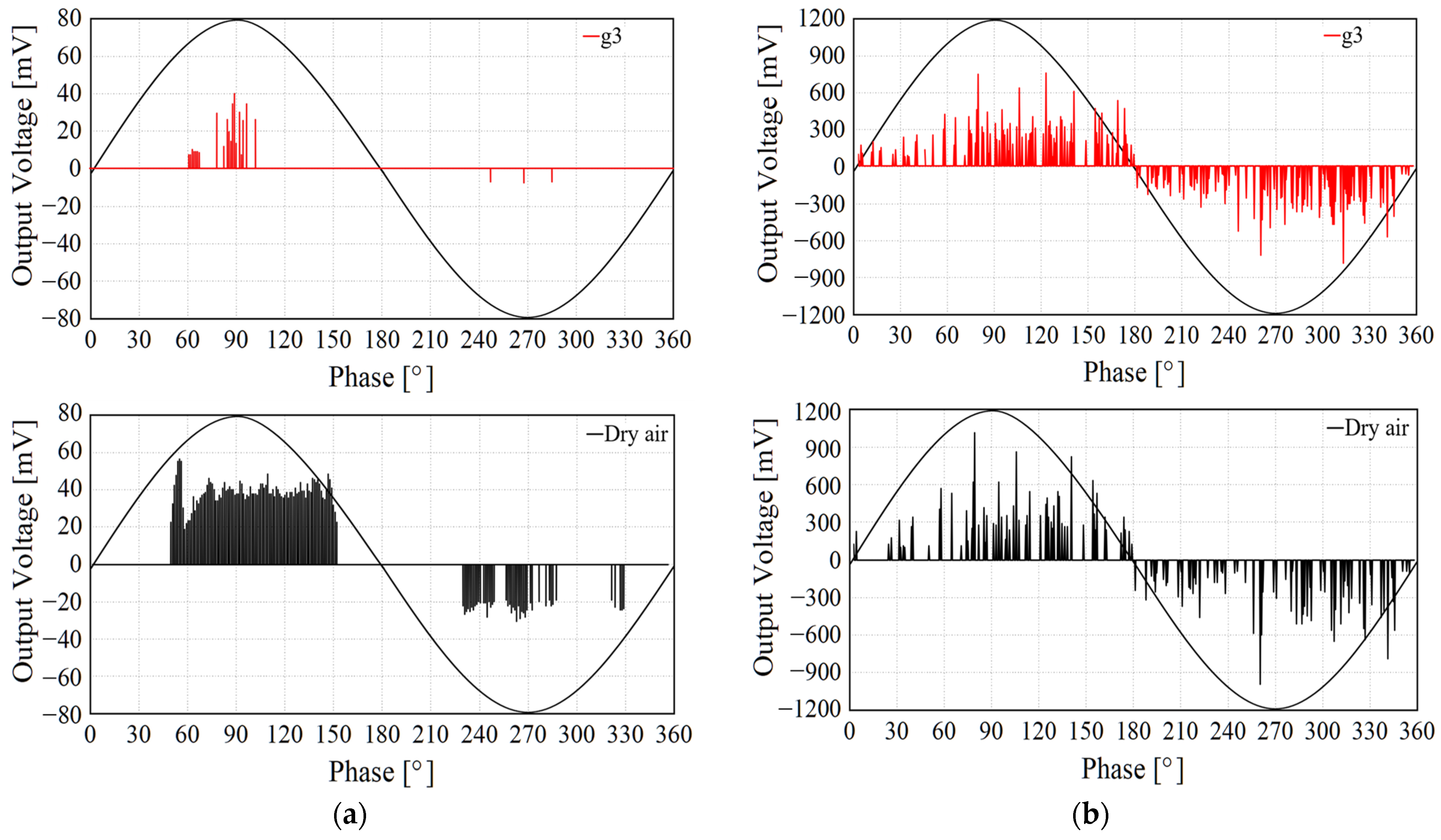
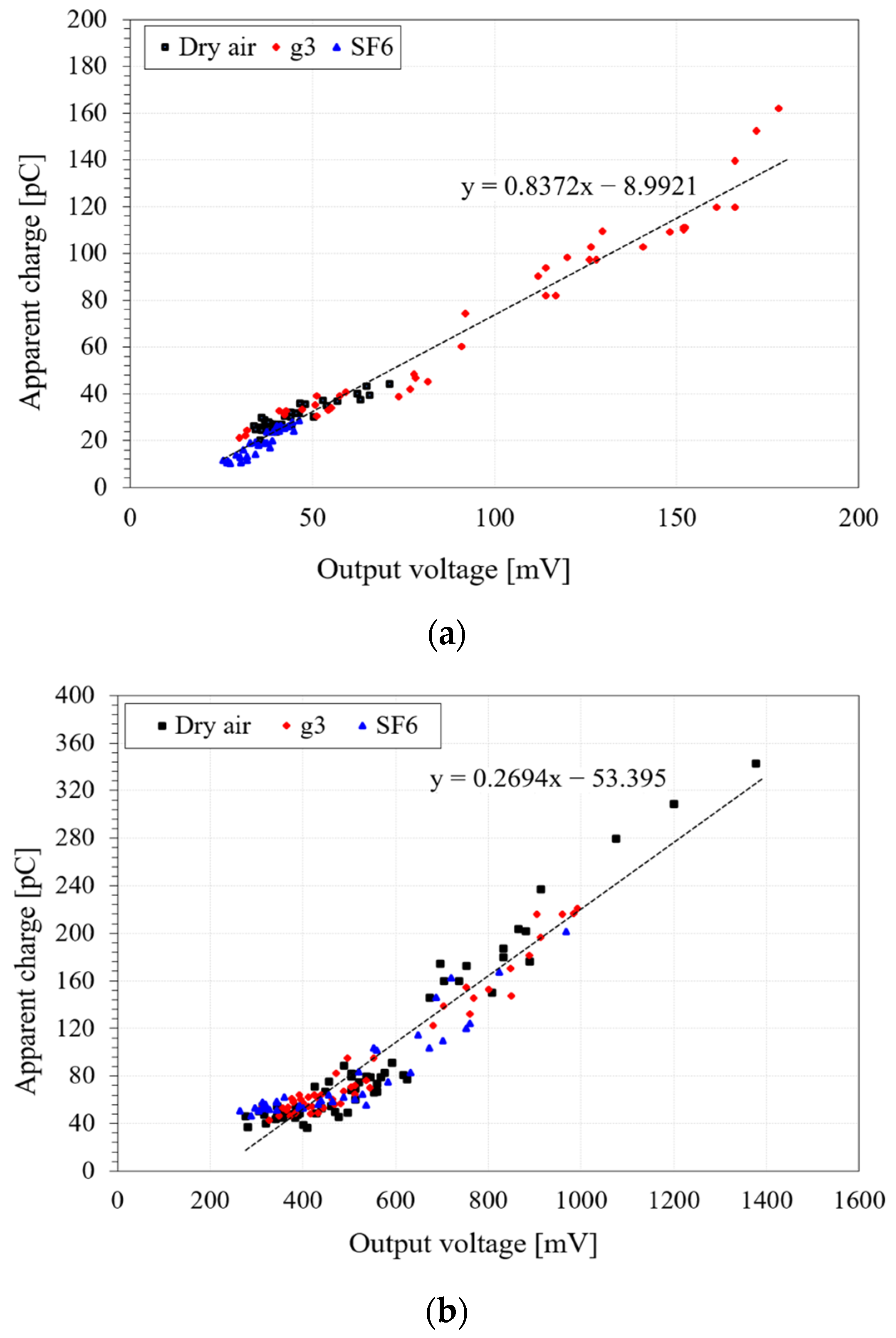
| Electrode Systems | Gases | Rising Time (μs) | Falling Time (μs) | Pulse Width (μs) |
|---|---|---|---|---|
| POC | SF6 | 124 | 132 | 272 |
| g3 | 152 | 143 | 298 | |
| Dry air | 171 | 146 | 304 | |
| FMP | SF6 | 116 | 67 | 144 |
| g3 | 125 | 84 | 186 | |
| Dry air | 124 | 92 | 192 |
| Electrode System | Gas | Average Output Voltage (mV) | Pulse Count (N/s) |
|---|---|---|---|
| POC | SF6 | 27.1 | 24 |
| g3 | 31.6 | 42 | |
| Dry Air | 40.3 | 1716 | |
| FMP | SF6 | 434 | 90 |
| g3 | 459 | 123 | |
| Dry Air | 484 | 135 |
Publisher’s Note: MDPI stays neutral with regard to jurisdictional claims in published maps and institutional affiliations. |
© 2022 by the authors. Licensee MDPI, Basel, Switzerland. This article is an open access article distributed under the terms and conditions of the Creative Commons Attribution (CC BY) license (https://creativecommons.org/licenses/by/4.0/).
Share and Cite
Shin, G.-C.; Kim, S.-W.; Kil, G.-S. Comparison between the PD Characteristics of g3 and Dry Air for Gas-Insulated Switchgears. Energies 2022, 15, 7043. https://doi.org/10.3390/en15197043
Shin G-C, Kim S-W, Kil G-S. Comparison between the PD Characteristics of g3 and Dry Air for Gas-Insulated Switchgears. Energies. 2022; 15(19):7043. https://doi.org/10.3390/en15197043
Chicago/Turabian StyleShin, Goang-Chul, Sung-Wook Kim, and Gyung-Suk Kil. 2022. "Comparison between the PD Characteristics of g3 and Dry Air for Gas-Insulated Switchgears" Energies 15, no. 19: 7043. https://doi.org/10.3390/en15197043
APA StyleShin, G.-C., Kim, S.-W., & Kil, G.-S. (2022). Comparison between the PD Characteristics of g3 and Dry Air for Gas-Insulated Switchgears. Energies, 15(19), 7043. https://doi.org/10.3390/en15197043






